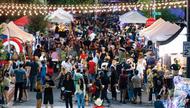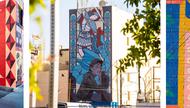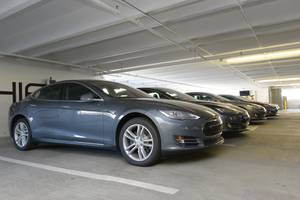“I really need to do something with this room.”
Michael Cornthwaite enters a nondescript room adjacent to the Beat coffeehouse on East Fremont Street. It’s the first space patrons see before entering the main hallway of the Emergency Arts co-op, but they couldn’t be blamed for overlooking it. Limited to a couch, a few chairs and a coat of paint on the walls, it recalls a barren dormitory common area where students might escape the clatter of their usual work area for a quieter one.
For Cornthwaite, who owns or is a partner in 11 downtown ventures, including the Beat and Emergency Arts, it provides a similar respite.
But the room also symbolizes a lingering, perpetually unprioritized task on his enormous to-do list. One imagines him busy, say, with the latest delivery of Kubler Absinthe at Downtown Cocktail Room, or evaluating the sales of obscure titles at the new Inspire News Café or tasting cured meats for the charcuterie service at the even newer Scullery.
Las Vegas has always needed a more urbane identity and a galvanizing point for residents. And Cornthwaite had always envisioned it happening downtown—before the media buzz, before he opened his first bar there, before Tony Hsieh moved into the neighborhood and before there was even an entertainment district to enable such things.
He wasn’t the only one who wanted to see locals-friendly development downtown, but he was one of the first to hit the streets, have the necessary conversations and take the plunge with his own businesses. He channeled his doggedness and ignored others’ skepticism long enough to become a pioneer of one of the nation’s most exciting metropolitan renaissances.
Downtown bound
Michael Cornthwaite is from Las Vegas. At least that’s what he’ll tell you if you ask him—which you shouldn’t, because he loathes the question and he’s worked hard so you won’t.
Cornthwaite is actually from Wyoming. He came of age in rural Illinois, and after graduating college tended bars in Chicago. Weather drudgery and ongoing career soul-searching motivated him to move to Las Vegas in 1995, where most his family was also relocating.
Upon arrival, he took a job at an insurance company. “I thought, it’s time to be a grown-up, get a tie job,” he says. “I hated it. I’m not a salesman for something I don’t believe in.”
So, he parked cars at the just-opened Stratosphere and offered to intern for free at the property’s eateries so he could get his foot into the dining world. And he was a salesman for the right opportunity, not only talking the Stratosphere brass into it, but parlaying months of dues-paying grunt work into a leadership position at the highly profitable Top of the World restaurant, before serving as general manager at Green Valley Ranch’s Whiskey Sky, one of Las Vegas’ first ultralounge concepts. Slowly, Cornthwaite was enhancing his professional pedigree—and finding his place in Las Vegas.
All during his steady climb up the local service-industry ladder, Cornthwaite was spending his time off downtown. At first, he fantasized about owning a home in the area, but he couldn’t afford it. Then, driving the streets of the depressed commercial area and seeing all the empty storefronts and buildings, he began to envision his own business—and the possibility of a thriving urban environment with a walkable nightlife and retail district. It would be the Las Vegas version of what he had been accustomed to in other large cities.
Still feeling disconnected five years into his Vegas residency, Cornthwaite saw downtown as “a home for locals to hang out, live together and lead somewhat of a normal social existence—and to connect with one another.”
He began pounding the pavement, calling phone numbers on for-lease signs, asking about rental agreements, zoning, financing—getting a guerrilla education in entrepreneurship. He interrogated landlords, including Frank Elam, from whom Cornthwaite would eventually rent property for a commercial cleaning business.
“I would say to him, this is what I believe and think should happen [downtown],” Cornthwaite recalls. “And finally he said, look, you’ve got ideas, but I don’t think they’ll work. It’s been this way forever—but you should meet someone at the city.”
That someone was Douglas Lein.
An entertainment district is born
Lein’s rapid-fire conversation mode differs from Cornthwaite’s more Zen-like intonation. But he shares the entrepreneur’s enthusiasm for the area’s revitalization, even now as the economic development manager for Auburn, Washington.
He frequently references “the dream,” the establishment and steady evolution of the Fremont East Entertainment District and how then-Mayor Oscar Goodman let city staffers pursue it, how those staffers sold it to the private sector and landowners, and how the private sector ran with it, infusing money, imagination and life into the formerly discounted six-block area.
One of those early responders was Cornthwaite. “I was tickled pink to have someone like Michael who believed the dream and had the vision,” says Lein, then head of the Office of Business Development. “He was the perfect guy.”
But he was also “just a kid,” as Cornthwaite puts it, with no credibility, no property, no reason anyone should listen to him. He eventually learned that to appeal to downtown landowners—who were required to come to a consensus regarding the establishment of an entertainment district—he had to talk in terms of money, not community.
One person who did hear Cornthwaite out was Lein, who gave the budding entrepreneur advice on things like zoning requirements and assessments for a potential venue, as the former shared his ideas on how to boost the city’s urban bonafides.
“Having someone like Michael who had fresh ideas was a great wealth of knowledge for us,” Lein says. “We drew upon a lot of his ideas. He was there at the very beginning. He wanted to get his own [establishment] and stop working for the [casinos]. … He had the right feel, touch and smell that you know he’d be successful. And the mayor really liked him.”
To this day, Cornthwaite marvels at the idea that Las Vegas—unlike most big cities—has such accessible government officials, the mayor included. Oscar Goodman was bullish on downtown from day one—as he was on this so-called kid with no credibility.
“He was not a virgin,” says the former mayor. “He had a great background with food and beverage and hotels. He wasn’t a rookie. … He was very cool and very focused. He knew exactly what he wanted to accomplish.”
The process and lobbying effort for the entertainment district took more than two years, but in 2002, a “supermajority” of landowners agreed to the redevelopment plan. A cheaper, tavern-limited license was born; gaming was limited to the El Cortez; live entertainment requirements were established; and landowners agreed to pay some of the street and sidewalk improvements. A Board of Directors was also formed, and Cornthwaite was eventually voted in as the first non-property-owner member.
With the establishment of Fremont East, it seemed Cornthwaite’s dream of a bustling, revitalized downtown might actually come to fruition—and he was excited to be a part of it. Now, he just needed something of his own that would allow him to make his mark.
The stigma of one-way streets
Even before the establishment of the entertainment district, Cornthwaite had ideas for a bar—something cosmopolitan that might remind people of their favorite big-city spots, but distinct enough to feel proprietary to Las Vegas and its new nighttime destination. It would draw locals and foment conversations. It would be a place where fellow residents could bond over their similarities, not fixate on their differences.
“If you’re here, and if you’re living and working here, and your family is here, why are you always from somewhere else?” says Cornthwaite, sounding more like a typical bar patron than a bar owner. “To me, there wasn’t enough of a sense of pride, of people putting down roots. And I felt this was an area where this could happen.”
He rented a space on Las Vegas Boulevard just off Fremont from a landlord who owned the parcel now occupied by venues like Inspire and the Griffin. And Cornthwaite quit his managing gig at former Paris club Risque, his final Strip job. He was going all-in on the downtown dream.
He quickly learned, however, that building a new space is easier than renovating an old one and bringing it fully up to code. Countless setbacks and city requirements—including grease traps, fire sprinklers and an elevator he wouldn’t need—surfaced not only for the space he’d rented, but for the entire building.
“I was showing how young and green I was, because it never occurred to me that you had to do all these things.”
A project he thought would take no more than six months and $500,000 ended up crossing the two-year mark and costing more than a million dollars. On the final opening date, January 27, 2007, Cornthwaite unveiled Downtown Cocktail Room to the public.
It was immediately deemed “swanky,” but that descriptor belied its tangibility. The mystery of its minimal lighting and deep-red accents eventually gave way to intimacy. Experienced DJs such as Douglas Gibbs and Carlos Sanchez got patrons moving to a warm, uplifting house soundtrack, and mixology-oriented bartenders created savory libations that not only seduced the Jack-and-Coke crowd, but helped usher in the Valley’s embrace of signature cocktail menus. In 2007, Vegas bar culture seemed to discernibly evolve. So did downtown.
DCR was an immediate hit with those already living or frequenting downtown (Beauty Bar had opened two years earlier, and the debut of the Griffin completed the bar-hopping trifecta), and even some outside of it.
“It’s a 20-minute drive from my house, but it has always felt like my neighborhood bar,” says artist Michael Monson.
Artist and downtown resident Jerry Misko says, “I’ve been going to DCR since day one. Nice places to socialize and have a drink were few and far between then, outside of the casinos. It appealed to me on many levels.”
Nonetheless, with no marketing budget, a location with a reputation for crime and a door camouflaged to ward off drunken tourists, the bar struggled to draw. Cornthwaite would repeatedly invite the tellers at his nearby bank to come by for happy hour; one finally relented but gave up once he realized he had to drive on one-way streets.
“In spite of the fact there were 20,000 or 30,000 employees working down here every day, I had no clue as to how difficult it would be to convince them to stay—that this was a legitimate option for entertainment,” Cornthwaite says.
Still, Cornthwaite, a great salesman for something he believes in, continued to network and made those who did show up feel at home. Back then I might pre-game at DCR before a Beauty Bar concert just to hear him weigh in on progress in the neighborhood. DCR may not have been prosperous back then, but it did what Cornthwaite set out to do: create a downtown stomping ground, minus the stomp.
Unfortunately, his struggles were only beginning.
Recession be damned
The 2008 recession couldn’t have come at a worse time for Cornthwaite, who estimates that he lost half of the customer base he’d worked so hard to build by year’s end.
He looked for other opportunities—anything to, 1. restore the momentum that Fremont East enjoyed in 2007 and, 2. retain his professional independence and stay off the Strip. But doubt dogged him and his then-girlfriend, Jennifer. They were struggling with their budgets and unsure of downtown’s future. Privately, they pondered the unthinkable: bailing on downtown, even after 10 years of groundwork, persistence and minor victories.
“We did talk a lot about moving,” says Cornthwaite, “because it was just like, how are we going to hedge our bets? How are we going to plan if this doesn’t happen or work out?”
In early 2009 they made a promise: to live more in the moment and give Las Vegas one more year.
They doubled down on the Fremont Medical Arts building on the corner of Fremont and Sixth streets, which had been vacant save for the third floor for 10 years. The idea: a creative collective with artists, retailers and non-profits on the first floor anchored by a native coffeehouse that would not only serve the voluble call for one, but provide a daytime meeting place for locals.
“We just wanted to do something that, in my head, felt normal,” Cornthwaite says. “Coffee, some food, good community hangout. Let’s do some vinyl records and make this place feel like Anyplace, USA.”
It took almost a year, but his proposal to the executives at El Cortez, which owned the building, finally got green-lit. The casino agreed to a $30,000 loan, and Cornthwaite began construction work, while Jennifer, a former gallery owner, reached out to possible tenants to occupy the space. “Jen’s really the person who brought people in to occupy the space and make this project happen,” he says. They wed in 2010.
The Beat and Emergency Arts opened that same year, the former an immediate hit—especially with the same people who first frequented Downtown Cocktail Room—and the latter eventually filling its entire first floor and expanding onto the second. They were a singular blast of capital-C culture on a street where community had revolved around cocktails. And they gave the couple something of a second wind—which in time would transform into a series of gusts, thanks to a fortuitous meeting with a certain CEO from Henderson.
The partnership that changed everything
Toward the end of 2009, Cornthwaite got The Call from Sarah Nisperos. Tony Hsieh was considering moving Zappos out of Southern Nevada, but wanted to know more about downtown. Nisperos asked Cornthwaite to chat with him, and 15 minutes later, Hsieh walked into Downtown Cocktail Room.
“Looking back on it, it wasn’t so much a conversation as a question-and-answer [session],” remembers Cornthwaite. “Tony’s got a very inquisitive mind. I didn’t know what he was thinking about ... it was more [him asking], ‘Why are you down here and what do you think the potential is? Do you know these people? Can I get this license? Is that building for sale?’”
The two spoke for hours that day, and continued to meet—sometimes at a competing bar, which confused Hsieh until Cornthwaite explained the importance of downtown bar owners supporting one another. Hsieh found this endearing, and soon spoke of downtown development as something more community-oriented.
It sounded good, but Cornthwaite kept his expectations low and his recommendations small.
Then one day in 2009, the two were walking on Las Vegas Boulevard when Hsieh asked about the building at 400 E. Stewart Ave. It was City Hall, and Cornthwaite said it would be vacated in a few years. “You could just see the wheels turning,” he remembers. A year later, Hsieh announced the purchase of the building. The talk had finally evolved into something real.
“Michael inspired us to relocate our headquarters to downtown,” Hsieh says. “His passion for downtown is infectious, and we wouldn’t be here if it weren’t for Michael.”
Zappos’ impending move raised questions about how the commercial (and residential) infrastructure of the Fremont East area would accommodate its 1,000-plus employees. Hsieh answered in part with his 2011 redevelopment program called the Downtown Project, a five-year, $350-million initiative designed to invite entrepreneurs of all economic levels and types to participate in the downtown rebound. In three years, it would fund and facilitate more than 100 businesses—a spread-the-wealth approach Cornthwaite says he advocated years earlier, albeit at much lower amounts, when single construction projects inched toward seven- and eight-figure investments.
Hsieh’s huge moves accelerated the development of the area. “He’s knocking 10 or 15 years off the process, if not more,” Cornthwaite says.
The portfolio builds
During the first of two chats in that barren Emergency Arts room, Cornthwaite constantly checks his phone—so much so that I expect him to cut the interview short. Though he never responds to it or even breaks his conversational flow, I know to keep things moving.
Cornthwaite initially signed up for two major DTP projects, Container Park and Inspire. (He’s since pulled out of the former.) For the latter, Hsieh bought the 16,000-square-foot parcel that houses DCR, becoming Cornthwaite’s partner on an adjoining two-story space called Inspire.
It bears the influence of Cornthwaite and his vision for the district, and includes three bars—the innovative members-only 365 Tokyo cocktail spot, a cozy lobby bar called the Wayfarer and an open-air rooftop drinkery—a 150-seat theater and a café/newsstand offering niche magazines like The Believer, Artforum and Bitch.
In May, Cornthwaite opened the Scullery on the ground level of the Ogden, another partnership with DTP, inspired by places he’d encountered during international travels and his wife’s ideas for a female-friendly bar.
Then there’s the Huntridge Theatre, one of the few off-Strip/non-casino music venues in Vegas until its closure in 2004. Cornthwaite saw the building’s value to both the adjacent neighborhood—where he’s a homeowner and former resident—and the history of downtown, despite its decay.
In 2013, Cornthwaite, First Friday Managing Partner Joey Vanas and Life Is Beautiful Festival founder Rehan Choudhry—the latter leaving the project shortly thereafter—announced a plan to acquire and restore the theater, and successfully crowdfunded $200,000 to show deep-pocketed investors that the public genuinely supported the endeavor. Cornthwaite says one of his main goals for the next year is finalizing plans for the Huntridge’s future.
The backlash of modest success
One June night in 2011, I see Jennifer Cornthwaite in front of the Beat and ask if she’s attending Electric Daisy Carnival. She asks about the admission price, and when I tell her it’s $200 for a three-day pass, her eyes damn near pop out of her head.
“There’s no way I can afford that!” she says. “My husband would kill me if I spent that kind of money.”
I had assumed the Cornthwaites opened the Beat and Emergency Arts because DCR had become a financial success, but even though it had earned acclaim and Michael had become an influencer downtown, the bar’s rough birth had meant going into debt and a close monitoring of his budget.
When Cornthwaite announced the Huntridge project, most championed his new cause, but skeptics raised questions about the viability and vague nature of the proposals, and the potential of the venture being for-profit. Others outright opposed his and Vanas’ involvement, accusing them of turning a sacred symbol of the community into a business opportunity and trying to gentrify the area like they said Cornthwaite and Hsieh were doing in the Fremont East district. The rhetoric got particularly heated; attacks frequently painted Cornthwaite and Vanas as rich white guys.
“It’s not like that all—it’s actually the opposite of that,” Cornthwaite says. “We’re just trying to make it happen for everybody, while leveraging ourselves [and] borrowing money ... and taking personal risks at the same time.”
Cornthwaite feels like his critics haven’t seen the struggles behind his rise to prominence—how he couldn’t afford to pay someone else to build the Beat or how he still worries about overdrafting his bank account each month. Despite his calm demeanor, he nonetheless hints at having little by way of financial security. And though he counts his blessings, he suggests the successes of small business owners like himself don’t match up with the American Dream others perceive them to be living.
If he doesn’t want to hear the criticism, Cornthwaite would seem fine without the praise, too. When pressed about whether he feels he gets his due credit, he makes a cursory acknowledgment, indulging only in the vindication that years of sweating it out has paid off. It would seem that he views the fruits of his labors less as accomplishments than involvement.
“When all is said is done, you want to look back at your life and say you did something,” he says. “I think anyone who’s been part of this and cares about it and participated, they can say that—myself included.”
“I think maybe Michael gets overshadowed now by DTP and those entities, but I think that’s the way he likes it,” Misko says. “I think he is in this for his business, for the neighborhood and for his family, not for accolades.”
Indeed, Cornthwaite’s promise to live more in the moment hasn’t taken him away from the daily grind. He is, after all, someone who describes himself more as a worker than an owner, or at least as an owner whose money isn’t making more money yet.
But even if he could afford to rest on his laurels, would he? It’s hard to imagine him taking a breather to behold how far downtown has come. He says he’ll do that when he’s 80, when he can survey the fully realized version of it—or something close to it. For Cornthwaite, that would be the true dream.
“I don’t think any of us here now will see what the enormous potential of downtown will look like, but we’re on the right track,” Cornthwaite says. “I firmly believe a generation or two or three from now, those people will look back and say, that must’ve been a really exciting time. I wish I could see that.”
Cornthwaite's downtown: A guide to the entrepreneur's varied venues
Downtown Cocktail Room The staple speakeasy serves fresh drinks to a sophisticated local crowd. 111 Las Vegas Blvd. S., 702-880-3696.
Oscar’s A partnership with former mayor Oscar Goodman and the Plaza, this steakhouse is set in the casino’s glass dome overlooking Fremont. The Plaza, 702-386-7227.
The Beat This downtown destination is a coffeehouse, record shop and intimate venue rolled into one. Emergency Arts, 520 Fremont St., 702-385-2328.
Emergency Arts A multi-use co-op site, EA houses more than 35 small businesses and the Life Is Beautiful Festival. 520 Fremont St., emergencyartslv.com.
Inspire Theatre This petite performance space inside the building of the same name hosts guest speakers, variety shows and more. 107 Las Vegas Blvd. S., 702-910-2388.
Inspire News Café One part café, one part magazine stand, the airy café is a comfy place to grab a latte and get some work done. 107 Las Vegas Blvd. S., 702-910-2388.
Scullery Go for the wine list, stay for the charcuterie and live jazz in the back room. The Ogden, 150 Las Vegas Blvd. N. #190, 702-910-2396.
The Roof Inspire’s top floor boasts an open-air social spot with fabulous views of the Fremont scene and cocktails made for sharing. 107 Las Vegas Blvd. S., 702-910-2391.
Wayfarer Bar A salute to mid-century socializing, this cozy room packs plenty of vintage ambiance and potent cocktails. 107 Las Vegas Blvd. S., 702-910-2390.
365 Tokyo A cocktail lover’s destination, this tiny members-only bar features a jazz menu, inventive drinks and artisanal ice. 107 Las Vegas Blvd. S., 702-910-2392.
Second Floor Lounge Another Inspire membership space, the lounge has meeting areas available for booking. 107 Las Vegas Blvd. S., 702-910-2392.










